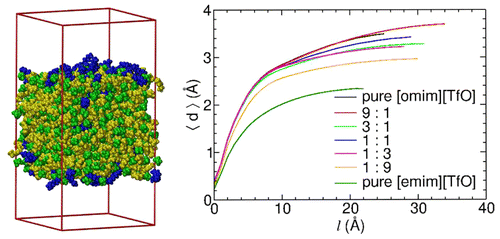当前位置:
X-MOL 学术
›
J. Phys. Chem. C
›
论文详情
Our official English website, www.x-mol.net, welcomes your
feedback! (Note: you will need to create a separate account there.)
Surface Structure and Dynamics of Ions at the Liquid–Vapor Interface of Binary Ionic Liquid Mixtures: Molecular Dynamics Studies
The Journal of Physical Chemistry C ( IF 3.3 ) Pub Date : 2016-03-04 00:00:00 , DOI: 10.1021/acs.jpcc.5b10868
Sourav Palchowdhury 1 , B. L. Bhargava 1
The Journal of Physical Chemistry C ( IF 3.3 ) Pub Date : 2016-03-04 00:00:00 , DOI: 10.1021/acs.jpcc.5b10868
Sourav Palchowdhury 1 , B. L. Bhargava 1
Affiliation

|
The surface structure and dynamics of ions at the liquid–vapor interface of binary mixtures of ionic liquids 1-n-octyl-3-methylimidazolium trifluoromethanesulfonate ([omim][TfO]) and 1-ethyl-3-methylimidazolium trifluoromethanesulfonate ([emim][TfO]) of varying composition have been studied using atomistic molecular dynamics simulations. Global definition of the interface and the identification of the truly interfacial molecule method (ITIM) have been used to analyze the structure and dynamics of the ions at the interface. We have seen enhancement in the density of the longer alkyl chain cation ([omim]) at the liquid–vapor interface compared to the bulk. The surface is mainly enriched with the [omim] cation, and it becomes smoother with a decrease in mole fraction of [omim] cations in the mixtures. The [omim] cation shows greater survival probability at the liquid–vapor interface than other ions, and this probability increases with a decrease in mole fraction of [omim] cations. The reorientational correlation function suggests that the [omim] cations prefer to retain their orientation with respect to the interface normal for a longer time. The movement of ions in and out of the interface is facilitated by the out-of-plane rotation of the ions with respect to the interface.
中文翻译:

二元离子液体混合物的液-汽界面处离子的表面结构和动力学:分子动力学研究
离子液体1- n的二元混合物在液-气界面处的离子的表面结构和动力学使用原子分子动力学模拟研究了三氟甲烷磺酸-辛基-3-甲基咪唑鎓三氟甲磺酸盐([omim] [TfO])和三氟甲烷磺酸1-乙基-3-甲基咪唑鎓三氟甲磺酸盐([emim] [TfO])。界面的全局定义和真正的界面分子方法(ITIM)的识别已用于分析界面处离子的结构和动力学。与本体相比,我们已经看到在液-气界面上较长烷基链阳离子([omim])的密度有所提高。表面主要富含[omim]阳离子,随着混合物中[omim]阳离子的摩尔分数降低,表面变得更光滑。与其他离子相比,[omim]阳离子在液-气界面处的存活概率更高,并且这种概率随着[omim]阳离子的摩尔分数的减少而增加。方向相关函数表明,[omim]阳离子更愿意相对于法线界面保持较长的时间。离子相对于界面的平面外旋转有助于离子进出界面。
更新日期:2016-03-04
中文翻译:

二元离子液体混合物的液-汽界面处离子的表面结构和动力学:分子动力学研究
离子液体1- n的二元混合物在液-气界面处的离子的表面结构和动力学使用原子分子动力学模拟研究了三氟甲烷磺酸-辛基-3-甲基咪唑鎓三氟甲磺酸盐([omim] [TfO])和三氟甲烷磺酸1-乙基-3-甲基咪唑鎓三氟甲磺酸盐([emim] [TfO])。界面的全局定义和真正的界面分子方法(ITIM)的识别已用于分析界面处离子的结构和动力学。与本体相比,我们已经看到在液-气界面上较长烷基链阳离子([omim])的密度有所提高。表面主要富含[omim]阳离子,随着混合物中[omim]阳离子的摩尔分数降低,表面变得更光滑。与其他离子相比,[omim]阳离子在液-气界面处的存活概率更高,并且这种概率随着[omim]阳离子的摩尔分数的减少而增加。方向相关函数表明,[omim]阳离子更愿意相对于法线界面保持较长的时间。离子相对于界面的平面外旋转有助于离子进出界面。

































 京公网安备 11010802027423号
京公网安备 11010802027423号